Cub Cadet EX3200 User Manual



INTRODUCTION
Welcome to the World of Cub Cadet Yanmar Tractor
Thank you for purchasing our tractor product that has been designed and manufactured based on our state-of-the-art technology and rich expertise in developing and manufacturing tractor products.
Handle your tractor correctly by following the instructions contained in this Operator’s Manual so that it provides you long years of reliable and faithful service.
This manual constitutes an indispensable part of your Cub Cadet Yanmar tractor product. Always keep the manual readily accessible.
Carefully study this manual to get familiar with the instructions and information contained in it. These instructions and information are helpful in using your tractor correctly and safely, and avoiding personal injury and other accidents during operation and servicing of the tractor.
When using any implement together with your tractor, also carefully study its operation manual so that you can use it safely, correctly and efficiently.
This manual is organized with sections arranged in a particular order so that you can better understand the safety messages and the controls on your tractor to help you operate your tractor correctly and safely. This manual will also help you answer questions about operation and servicing. An index is available at the end of this manual to assist you in quickly finding necessary information.
The machine shown in this manual may somewhat differ from your actual machine. However, this manual will still assist you in understanding the instructions associated with your tractor.
Before delivery of your machine, your Cub Cadet Yanmar dealer has performed a pre-delivery check to ensure that your tractor can long remain problem-free.
1 |
Ex2900 / 3200 Operator’s Manual |

TABLE OF CONTENTS
...................................................................................1. SAFETY PRECAUTIONS |
1-1 |
|
1. |
About This Manual .................................................................................................................. |
1-1 |
2. |
Safety Alert Symbol................................................................................................................. |
1-2 |
3. |
Precautions Before Operating Your Tractor ............................................................................ |
1-3 |
4. |
Safe Practices for Operating Your Tractor .............................................................................. |
1-4 |
|
1. Starting Your Tractor .............................................................................................................................................. |
1-4 |
|
2. Working with Your Tractor ..................................................................................................................................... |
1-5 |
|
3. Considerations for Safety of Children.................................................................................................................... |
1-5 |
5. |
Operating Your Tractor on Slopes........................................................................................... |
1-6 |
6. |
Traveling on a Road ................................................................................................................ |
1-7 |
7. |
Safe Practices for Parking Your Tractor.................................................................................. |
1-7 |
8. |
Operating the Power Take Off (PTO)...................................................................................... |
1-8 |
9. |
Using the 3-Point Hitch............................................................................................................ |
1-8 |
10.Safety Frame (Roll-Over Protective Structure) (ROPS) Precautions ...................................... |
1-8 |
|
11.Safe Practices for Servicing Your Tractor ............................................................................... |
1-9 |
|
12.Understanding the Tractor Safety Decals ............................................................................. |
1-11 |
|
|
Safety-Alert Symbol............................................................................................................................................. |
1-11 |
|
Care of DANGER, WARNING and CAUTION Decals......................................................................................... |
1-11 |
|
|
|
2. SERVICING THE TRACTOR .............................................................................. |
2-1 |
|
|
|
|
3. SPECIFICATIONS............................................................................................... |
3-1 |
|
1. |
Specifications Table ................................................................................................................ |
3-1 |
2. |
Traveling Speeds .................................................................................................................... |
3-2 |
|
|
|
4. IMPLEMENT CAPACITIES................................................................................. |
4-1 |
|
|
|
|
5. NAMES AND FUNCTIONS OF COMPONENTS ................................................ |
5-1 |
|
1. |
Appearance ............................................................................................................................. |
5-1 |
2. |
Operator Station Controls........................................................................................................ |
5-2 |
3. |
Instrument Panel, Switches and Hand Controls...................................................................... |
5-3 |
|
|
|
6. PRE-OPERATION CHECK ................................................................................. |
6-1 |
|
1. |
Pre-Operation Check............................................................................................................... |
6-1 |
2. |
Precautions Before the Operation ........................................................................................... |
6-1 |
3. |
Routine Check......................................................................................................................... |
6-1 |
4. |
Prevent damage to the Plastic Surfaces and Painted Surfaces.............................................. |
6-1 |
|
|
|
7. OPERATING THE ENGINE ................................................................................ |
7-1 |
|
1. |
Starting the Engine.................................................................................................................. |
7-1 |
|
Opening / Closing the Fuel Shut-Off Valve............................................................................................................ |
7-1 |
|
Engaging the Parking Brake.................................................................................................................................. |
7-2 |
|
Warming Up the Engine in Cold Weather.............................................................................................................. |
7-4 |
|
Checking the Lights on the Instrument Panel........................................................................................................ |
7-5 |
2. |
Starting the Engine in Cold Weather ....................................................................................... |
7-6 |
Ex2900 / 3200 Operator's Manual |
2 |
|
|
|
TABLE OF CONTENTS |
|
3. |
Shutting Down the Engine....................................................................................................... |
|
7-7 |
|
4. |
Restarting a stalled Engine ..................................................................................................... |
|
7-8 |
|
|
|
|
||
8. OPERATING THE TRACTOR............................................................................. |
|
8-1 |
||
1. |
Operating a New Tractor ......................................................................................................... |
|
8-2 |
|
|
1. |
Do not run the tractor at full speed during the first 50 operating hours period ...................................................... |
8-2 |
|
|
2. |
Changing the lubricating oil for the new tractor ..................................................................................................... |
|
8-2 |
2. |
Raising and Lowering the Roll-Over Protective Structure (ROPS) ......................................... |
8-3 |
||
|
1. |
Lowering (Folding Down) the Roll-Over Protective Structure (ROPS) .................................................................. |
|
8-3 |
|
2. |
Raising (Unfolding) the Roll-Over Protective Structure (ROPS)............................................................................ |
|
8-4 |
3. |
Operation of the Tractor .......................................................................................................... |
|
8-5 |
|
|
Adjusting the Operator's Seat................................................................................................................................ |
|
8-5 |
|
|
Fastening the Retractable Seat Belt...................................................................................................................... |
|
8-6 |
|
|
Turn Signals .......................................................................................................................................................... |
|
8-6 |
|
|
Headlights.............................................................................................................................................................. |
|
8-7 |
|
|
Hazard Lights ........................................................................................................................................................ |
|
8-7 |
|
|
Range Shift Lever.................................................................................................................................................. |
|
8-7 |
|
|
4-Wheel Drive Lever.............................................................................................................................................. |
|
8-8 |
|
|
Throttle Control Lever............................................................................................................................................ |
|
8-8 |
|
|
Drive Pedals ........................................................................................................................................................ |
|
8-10 |
|
|
Engaging the Cruise Control ............................................................................................................................... |
|
8-11 |
|
|
Disengaging the Cruise Control........................................................................................................................... |
|
8-11 |
|
4. |
Stopping Travel of the Tractor............................................................................................... |
|
8-12 |
|
|
Emergency Stop Procedure ................................................................................................................................ |
|
8-12 |
|
5. |
Parking the Tractor................................................................................................................ |
|
8-13 |
|
|
Engaging the Parking Brake................................................................................................................................ |
|
8-13 |
|
|
Disengaging the parking brake............................................................................................................................ |
|
8-13 |
|
6. |
Safe Practices for Operation ................................................................................................. |
|
8-14 |
|
|
1. |
Differential Lock ................................................................................................................................................... |
|
8-14 |
|
Engaging the Differential Lock............................................................................................................................. |
|
8-14 |
|
|
Disengaging the Differential Lock........................................................................................................................ |
|
8-14 |
|
|
2. |
Safely Driving the Tractor on Roads.................................................................................................................... |
|
8-15 |
|
3. |
Pushing or Towing the Tractor ............................................................................................................................ |
|
8-16 |
|
4. |
Transporting the Tractor on a Trailer................................................................................................................... |
|
8-17 |
|
5. |
Operating on Slopes............................................................................................................................................ |
|
8-17 |
|
Uphill / Downhill ................................................................................................................................................... |
|
8-19 |
|
|
Steep Downhill..................................................................................................................................................... |
|
8-19 |
|
|
6. |
About the Power Steering.................................................................................................................................... |
|
8-19 |
|
|
|
||
9. POWER TAKE OFF (PTO) ................................................................................. |
|
9-1 |
||
1. |
Operating the Power Take Off (PTO)...................................................................................... |
|
9-1 |
|
|
Engaging the Power Take Off (PTO) (when the operator is seated on the operator's seat) ................................ |
9-2 |
||
|
Disengaging the Power Take Off (PTO) (when the operator is seated on the operator's seat) ............................ |
9-3 |
||
2. |
Installing an Implement to the Power Take Off (PTO) Drivelines............................................ |
9-3 |
||
3. |
Using the Power Take Off (PTO) while the Tractor is Parked |
|
|
|
|
(when the operator is not seated on the operator's seat)........................................................ |
|
9-4 |
|
|
|
|
||
10.3-POINT HITCH AND DRAWBAR.................................................................... |
|
10-1 |
||
1. |
3-Point Hitch.......................................................................................................................... |
|
10-1 |
|
|
1. |
Prepare the Implement Being Mounted ............................................................................................................... |
|
10-1 |
|
2. |
Using the 3-Point Hitch........................................................................................................................................ |
|
10-2 |
|
Adjusting the Right Lift Link ................................................................................................................................. |
|
10-2 |
|
|
Top Link............................................................................................................................................................... |
|
10-2 |
|
|
Sway Links .......................................................................................................................................................... |
|
10-2 |
|
|
|
3 |
Ex2900 / 3200 Operator's Manual |
|

TABLE OF CONTENTS
2. |
Drawbar................................................................................................................................. |
10-3 |
|
Maximum Allowable Load on the Drawbar .......................................................................................................... |
10-3 |
|
Adjusting the Drawbar ......................................................................................................................................... |
10-3 |
3. |
Using the Safety Chain.......................................................................................................... |
10-4 |
......................................................................................11.HYDRAULIC SYSTEM |
11-1 |
||
1. |
3-Point Hitch Control System ................................................................................................ |
11-1 |
|
|
Operating the 3-Point Hitch Control Lever to Raise or Lower the 3-Point Hitch.................................................. |
11-1 |
|
|
Hydraulic Flow Control / Stop Knob..................................................................................................................... |
11-2 |
|
2. |
Controlling the Implement Control Valve............................................................................... |
11-3 |
|
|
Implement Control Lever ..................................................................................................................................... |
11-3 |
|
|
1. |
Using the Hydraulic Lock Lever........................................................................................................................... |
11-4 |
|
2. |
Regenerative System .......................................................................................................................................... |
11-4 |
|
Using the Implement Control Valve Regenerative Circuit ................................................................................... |
11-4 |
|
|
3. |
Connecting the Implement Hydraulic Hoses ....................................................................................................... |
11-5 |
....................................................................12.TIRES, WHEELS AND BALLAST |
12-1 |
|
1. |
Tires ...................................................................................................................................... |
12-1 |
2. |
Wheel Adjustment ................................................................................................................. |
12-2 |
|
Checking the Wheel Bolt Tightening Torque ....................................................................................................... |
12-2 |
|
Tread Centerline Width........................................................................................................................................ |
12-3 |
|
Adjusting the Rear Tread..................................................................................................................................... |
12-3 |
3. |
Ballast.................................................................................................................................... |
12-4 |
|
Front Ballast ........................................................................................................................................................ |
12-4 |
|
Maximum Weight................................................................................................................................................. |
12-5 |
|
Using Liquid Weight for the Tires ........................................................................................................................ |
12-5 |
................................................................................................13.MAINTENANCE |
13-1 |
||
1. |
Maintenance Check List ........................................................................................................ |
13-1 |
|
2. |
Lubricants.............................................................................................................................. |
13-2 |
|
3. |
Replacement Parts................................................................................................................ |
13-3 |
|
|
1. |
Technical Document ............................................................................................................................................ |
13-3 |
|
2. |
Parts .................................................................................................................................................................... |
13-3 |
........................................................................................14.PERIODIC SERVICE |
|
14-1 |
|
■ Warranty and Repair of the Engine ....................................................................................... |
|
14-1 |
|
1. |
Opening / Closing the Hood and Side Panels ....................................................................... |
14-2 |
|
|
1. Opening / Closing the Hood ................................................................................................................................ |
|
14-2 |
|
Opening the Hood ............................................................................................................................................... |
|
14-2 |
|
Closing the Hood ................................................................................................................................................. |
|
14-3 |
|
2. Opening / Closing the Side Panels...................................................................................................................... |
|
14-3 |
2. |
Daily Checks ......................................................................................................................... |
|
14-4 |
|
Checking the Engine Oil Level ............................................................................................................................ |
|
14-4 |
|
Inspecting the Transmission Oil Level................................................................................................................. |
|
14-5 |
|
Checking the Wheel Bolt Tightening Torque ....................................................................................................... |
|
14-5 |
|
Checking and Adjusting the Brake ...................................................................................................................... |
|
14-6 |
|
Checking and Adjusting the Clutch...................................................................................................................... |
|
14-7 |
|
Checking the Radiator Hoses and Clamps.......................................................................................................... |
|
14-7 |
|
Checking the Tire Air Pressure............................................................................................................................ |
|
14-8 |
|
Cleaning the Radiator Cooling Screen, Cooling Fins and Oil Cooler Pipe .......................................................... |
14-9 |
|
|
1. Cleaning the Radiator Cooling Screen ................................................................................................................ |
|
14-9 |
|
2. Cleaning the Radiator Cooling Fins..................................................................................................................... |
|
14-9 |
|
Cleaning the Grille and Side Screens................................................................................................................ |
|
14-10 |
Ex2900 / 3200 Operator's Manual |
4 |
|
|
|
|
|
|
TABLE OF CONTENTS |
|
Checking the Fuel line ....................................................................................................................................... |
|
14-10 |
|
|
Checking the Power Steering line ..................................................................................................................... |
|
14-10 |
|
|
Checking the Seat Belt and Roll-Over Protective Structure (ROPS)................................................................. |
|
14-10 |
|
|
Checking the Headlights, Hazard Lights, etc..................................................................................................... |
|
14-10 |
|
|
Checking the Cooling System ........................................................................................................................... |
|
14-11 |
|
|
Refilling the Fuel Tank....................................................................................................................................... |
|
14-12 |
|
|
Inspection Procedure for Safety Interlock System............................................................................................. |
|
14-13 |
|
|
1. |
Range Shift Lever Neutral Switch...................................................................................................................... |
|
14-14 |
|
2. |
Mid-Power Take Off (PTO) Engagement Lever Switch (option)........................................................................ |
|
14-14 |
|
3. |
Rear Power Take Off (PTO) Engagement Lever Switch ................................................................................... |
|
14-15 |
|
4. |
Seat Safety Switch ............................................................................................................................................ |
|
14-15 |
|
5. |
Checking the Operation of the Seat Safety Switch............................................................................................ |
|
14-16 |
3. |
First 50 Hours...................................................................................................................... |
|
14-16 |
|
|
Change the Engine Oil ...................................................................................................................................... |
|
14-16 |
|
|
Replacing the Engine Oil Filter .......................................................................................................................... |
|
14-16 |
|
|
Replacing the Transmission Oil Filter................................................................................................................ |
|
14-16 |
|
|
Changing the Transmission Oil ......................................................................................................................... |
|
14-16 |
|
|
Cleaning the Transmission Strainer .................................................................................................................. |
|
14-16 |
|
4. |
Every 50 Hours.................................................................................................................... |
|
14-17 |
|
|
Checking the Front Axle Oil Level ..................................................................................................................... |
|
14-17 |
|
|
Grease Specifications........................................................................................................................................ |
|
14-17 |
|
|
1. |
Lubricating Grease Fittings on the Tractor ........................................................................................................ |
|
14-18 |
|
2. |
Lubricating the Hydraulic Implement Control Valve Linkage ............................................................................. |
|
14-19 |
|
3. |
Lubricating the Seat Slide Rails......................................................................................................................... |
|
14-19 |
|
4. |
Lubricating the 3-Point Hitch ............................................................................................................................. |
|
14-19 |
|
Servicing the Fan and Alternator Belt................................................................................................................ |
|
14-20 |
|
|
1. |
Checking the Belt Tension ................................................................................................................................. |
|
14-20 |
|
2. |
Adjusting the Belt Tension................................................................................................................................. |
|
14-20 |
|
3. |
Replacing the Belt ............................................................................................................................................. |
|
14-20 |
|
Checking the Fuel / Water Separator ................................................................................................................ |
|
14-21 |
|
|
Checking the Battery Condition ......................................................................................................................... |
|
14-21 |
|
5. |
Every 100 Hours.................................................................................................................. |
|
14-22 |
|
|
Servicing the Air Filter Element ......................................................................................................................... |
|
14-22 |
|
|
1. |
Servicing the Primary Air Filter Element............................................................................................................ |
|
14-22 |
|
2. |
Servicing the Secondary Air Filter Element ....................................................................................................... |
|
14-23 |
|
Cleaning the Fuel / Water Separator and Replacing the Fuel Filter .................................................................. |
|
14-24 |
|
6. |
Every 200 Hours.................................................................................................................. |
|
14-25 |
|
|
Engine Oil .......................................................................................................................................................... |
|
14-25 |
|
|
Changing the Engine Oil and Filter.................................................................................................................... |
|
14-25 |
|
|
Inspecting and Adjusting the Toe-in .................................................................................................................. |
|
14-26 |
|
|
Checking the Air Intake Hoses and Clamps ...................................................................................................... |
|
14-26 |
|
7. |
Every 300 Hours.................................................................................................................. |
|
14-27 |
|
|
Transmission Oil................................................................................................................................................ |
|
14-27 |
|
|
Changing the Transmission Oil and Filter, Cleaning the Transmission Oil Strainer |
..........................................14-27 |
||
8. |
Every 500 Hours.................................................................................................................. |
|
14-29 |
|
|
Front Axle Case Oil ........................................................................................................................................... |
|
14-29 |
|
|
Changing the Front Axle Case Oil ..................................................................................................................... |
|
14-29 |
|
|
Replacing the Fuel Filter.................................................................................................................................... |
|
14-30 |
|
9. |
Every 1000 Hours................................................................................................................ |
|
14-31 |
|
|
Servicing the Cooling System............................................................................................................................ |
|
14-31 |
|
|
1. |
Draining the Cooling System ............................................................................................................................. |
|
14-31 |
|
2. |
Flushing the Cooling System............................................................................................................................. |
|
14-32 |
|
3. |
Filling the Cooling System ................................................................................................................................. |
|
14-32 |
|
Recommended Engine Coolant......................................................................................................................... |
|
14-33 |
|
|
Adjusting the Engine Valve Clearance .............................................................................................................. |
|
14-33 |
|
|
Checking the Fuel Injection Nozzle ................................................................................................................... |
|
14-33 |
|
|
|
5 |
Ex2900 / 3200 Operator's Manual |
|

TABLE OF CONTENTS
Checking the Fuel Injection Pump..................................................................................................................... |
14-33 |
10.General Maintenance .......................................................................................................... |
14-34 |
Selecting the Rotational Direction of Front Tires ............................................................................................... |
14-34 |
Changing Wheel Spacing and Tread Width ...................................................................................................... |
14-34 |
.......................................................15.SERVICING THE ELECTRICAL SYSTEM |
15-1 |
|
1. |
Battery ................................................................................................................................... |
15-1 |
|
Special Note for the Battery................................................................................................................................. |
15-1 |
|
Servicing the Battery Safely ................................................................................................................................ |
15-2 |
|
Inspecting the Battery.......................................................................................................................................... |
15-3 |
|
Removing and Installing the Battery.................................................................................................................... |
15-3 |
|
1. Removing the Battery .......................................................................................................................................... |
15-3 |
|
2. Installing the Battery ............................................................................................................................................ |
15-4 |
|
Cleaning the Battery and Terminals .................................................................................................................... |
15-4 |
|
Using a Booster Battery....................................................................................................................................... |
15-5 |
2. |
Fuses..................................................................................................................................... |
15-6 |
|
Replacing the Accessory Fuses .......................................................................................................................... |
15-6 |
|
Checking the Alternator Fuse and the Main Fuse ............................................................................................... |
15-6 |
3. |
Bulb ....................................................................................................................................... |
15-7 |
|
Replacing the Headlight Bulb .............................................................................................................................. |
15-7 |
|
Replacing the Tail Light Bulb............................................................................................................................... |
15-8 |
|
Replacing the Turn Signal / Hazard Lights Bulb.................................................................................................. |
15-8 |
|
Replacing the Instrument Panel Light Bulb ......................................................................................................... |
15-9 |
4. |
Headlights ............................................................................................................................. |
15-9 |
|
Adjusting the Headlights...................................................................................................................................... |
15-9 |
.........................................................................................................16.STORAGE |
16-1 |
||
1. |
Safe Practices for Storage .................................................................................................... |
16-1 |
|
|
1. |
Preparing the Machine for Storage...................................................................................................................... |
16-1 |
|
2. |
Preparing the Fuel and Engine for Storage ......................................................................................................... |
16-2 |
|
Fuel...................................................................................................................................................................... |
16-2 |
|
|
Engine ................................................................................................................................................................. |
16-2 |
|
2. |
Preparing the Stored Tractor for Operation........................................................................... |
16-3 |
|
......................................................................................17.TROUBLESHOOTING |
17-1 |
|
1. How to Use the Troubleshooting Table ................................................................................. |
17-1 |
|
1. |
Engine ................................................................................................................................................................. |
17-1 |
2. |
Machine ............................................................................................................................................................... |
17-2 |
3. |
Brake ................................................................................................................................................................... |
17-3 |
4. |
Steering ............................................................................................................................................................... |
17-3 |
|
|
|
18.INDEX................................................................................................................ |
18-1 |
|
Ex2900 / 3200 Operator's Manual |
6 |

1.SAFETY PRECAUTIONS
1.SAFETY PRECAUTIONS
1. About This Manual
This operator’s manual presents you messages that help you remain aware of potential hazards and possible machine damage in operating and servicing your machine. Carefully study all the information in it so that you can positively avoid personal injury and damaged properties.
NOTE:
●Unless otherwise stated, the expressions–right-hand side, left-hand side, front side, and rear side, used throughout this manual refer to the sides relative to the direction of forward movement with the tractor.
|
|
LEFT |
REAR |
|
|
3013701 |
RIGHT |
FRONT |
1-1 |
Ex2900 / 3200 Operator's Manual |
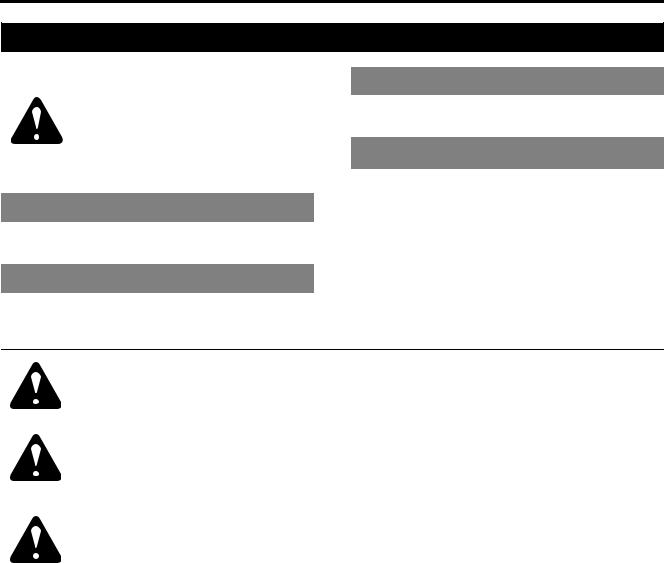
1. SAFETY PRECAUTIONS
2. Safety Alert Symbol
The safety alert symbol appear with most safety statements. It means attention, become alert, your safety is involved! Please read and strictly observe the message that follows the safety alert symbol.
 DANGER
DANGER
Indicates a hazardous situation which, if not avoided, will result in death or serious injury.
 WARNING
WARNING
Indicates a hazardous situation which, if not avoided, could result in death or serious injury.
 CAUTION
CAUTION
Indicates a hazardous situation which, if not avoided, could result in minor or moderate injury.
NOTICE
Indicates a situation which can cause damage to the machine, personal property and/or the environment or cause the equipment to operate improperly.
IMPORTANT: Means that implement or property damage could occur if instructions are ignored.
NOTE: Provides useful information.
WARNING: READ AND FOLLOW ALL INSTRUCTIONS IN THIS MANUAL BEFORE ATTEMPTING TO OPERATE YOUR TRACTOR. FAILURE TO COMPLY WITH THESE INSTRUCTIONS MAY RESULT IN PERSONAL INJURY.
WARNING: The engine exhaust, some of its constituents, and certain vehicle components contain or emit chemicals known to the State of California to cause cancer, birth defects or other reproductive harm.
DANGER: Your tractor was built to be operated according to the rules for safe operation in this manual. As with any type of power equipment, carelessness or error on the part of the operator can result in serious injury. To help prevent accidents, read and take the following precautions before operating this tractor. Failure to observe the following safety instructions could result in serious injury or death.
Ex2900 / 3200 Operator's Manual |
1-2 |
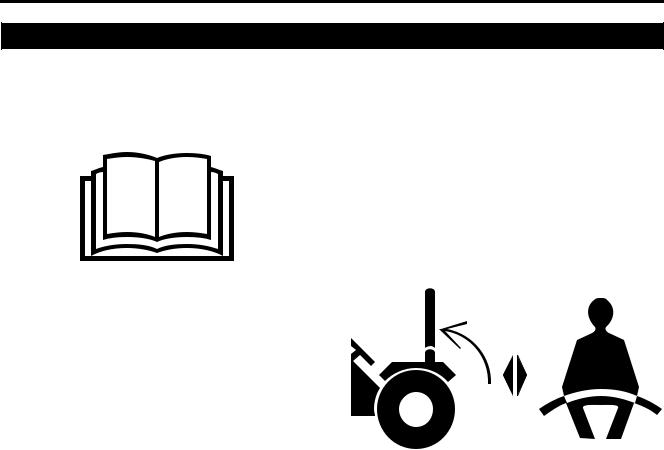
1. SAFETY PRECAUTIONS
3. Precautions Before Operating Your Tractor
1.Understand the performance and limitations of your tractor. Carefully study this operator’s manual and learn the instructions in it before operating or servicing your tractor. Keep the Operator’s Manual in an easily accessible place.
2.Strictly follow the statements given in the DANGER, CAUTION and WARNING safety decals attached to the tractor.
3.Do not operate the tractor with the Roll-Over Protective Structure (ROPS) in the folded position.
Keep the seat belt fastened while operating the tractor with the Roll-Over Protective Structure (ROPS) up. This practice will reduce the possibility of injury or death in the event of rollover accident.
If the Roll-Over Protective Structure (ROPS) has been removed for any reason, be sure to reinstall all the associated parts before operating the tractor.
Do not alter the Roll-Over Protective Structure (ROPS). The altered Roll-Over Protective Structure (ROPS) may fail to provide the designed protection.
Replace the damaged Roll-Over Protective Structure (ROPS) immediately. Contact your local Cub Cadet Yanmar dealer for technical assistance.
The foldable Roll-Over Protective Structure (ROPS) may be temporarily folded down when absolutely necessary for areas with height limitations. Remember that when the Roll-Over Protective Structure (ROPS) is in the folded position, the Roll-Over Protective Structure (ROPS) does not provide operator protection and the seat belt should not be worn.
For operator safety, always keep the Roll-Over Protective Structure (ROPS) in the upright and locked position.
NEVER alter or repair the Roll-Over Protective Structure (ROPS). Welding, bending, drilling, grinding, or cutting may weaken the Roll-Over Protective Structure (ROPS) structure. Contact
your local Cub Cadet Yanmar dealer for technical assistance.
4.Always fasten the seat belt while operating the tractor with the Roll-Over Protective Structure (ROPS) up.
Check the seat belt for any damage. Replace the damaged seat belt immediately. Contact your local Cub Cadet Yanmar dealer for technical assistance.
Do not use the seat belt if the foldable Roll-Over Protective Structure (ROPS) is in the folded position or the tractor does not have the RollOver Protective Structure (ROPS).
5.Check overhead clearance carefully before driving under power lines, wires, bridges or low hanging tree branches, before entering or leaving building, or in any other situation where the operator and/or Roll-Over Protective Structure (ROPS) may be struck, which could result in serious injury.
6.Make sure that any person (other than a usual operator) who will operate the tractor studies this operator’s manual before operation. Know the controls and how to stop the machine quickly.
7.Make sure that any person or obstacle is not under or around the tractor before and during operation. Be sure to maintain sufficient overhead clearance above the tractor.
8.Do not operate your tractor and/or implement installed to it while you are under the influence of alcohol, drug, medicine or controlled substance(s) or when you are not fit for operation of your tractor.
9.For operation, wear close-fitting clothing. When operating the tractor or working around the tractor, do not wear loose-fitting clothes or jewelry, or baggy or damaged clothing. When caught by a moving part of the tractor, an accident can result. Cut-off pants or shorts do not provide protection against flying debris. Never operate the tractor in bare feet, sandals, or
1-3 |
Ex2900 / 3200 Operator's Manual |

1. SAFETY PRECAUTIONS
sneakers. Wear additional protections including non-slip safety boots or shoes, and safety goggles and gloves, etc. as appropriate or required by currently applicable local laws and regulations. Wear ear protection in a noisy environment to prevent hearing damage and reduce operator fatigue.
10.NEVER allow a passenger on any portion of the tractor.
11.Remain seated in the operator’s station when operating the tractor.
12.Make sure that the brakes, clutch and other mechanical components are free from misadjustment and excessive wear. Replace any excessively worn or damaged component immediately. At regular intervals, check that all the nuts, bolts and screws are appropriately tightened. (For details, see “MAINTENANCE”)
13.Always keep your tractor clean. Dust, grease or grass clippings accumulated on your tractor can lead to fire accidents or personal injury.
14.Use the handholds and running board steps when getting on and off the tractor to help prevent accidental falls. Keep the running boards clear of mud and debris.
15.Only use the implements that satisfy the requirements in this manual or are approved by your Cub Cadet Yanmar dealer. (See “4. IMPLEMENT CAPACITIES”)
16.When using front or rear mounted implements, install an appropriate weight(s) to the front or rear of your tractor to prevent upsetting of the tractor. If you choose to use the front loader, mount an implement or ballast to the 3-point hitch in order to get the tractor to stabilize. Observe the instructions about safety in the manual for the implement to be used.
17.Remember that a narrower tread width can lead to greater possibility of upsetting of the tractor. To positively stabilize your tractor, select a maximum possible tread width appropriate for your intended application. (For details, see the “Wheel Adjustment” on page 12-2)
18.Do not attempt to modify your tractor. Modification can deteriorate the performance and/or safety of your tractor, possibly leading to personal injury or property damage.
4. Safe Practices for Operating Your Tractor
1. Starting Your Tractor
1.Remain seated in the operator’s station when starting the engine, or actuating the levers or controls. Do not start the engine or operate controls while standing beside the tractor.
2.Before starting the engine, make sure that all the levers are in the neutral positions, the parking brake is engaged securely, and the clutch and the Power Take Off (PTO) are disengaged.
3.Always keep the seat belt fastened around your waist whenever the Roll-Over Protective Structure (ROPS) is in the upright and locked position.
4.If you must start the tractor where there is a height limitation, as soon as possible return the Roll-Over Protective Structure (ROPS) to the upright and locked position and fasten the seat belt.
5.Start the engine of your tractor only by using the starter key switch. Do not attempt to start the tractor engine by short-circuiting across the starter solenoid terminals with a jumper wire, or
Ex2900 / 3200 Operator's Manual |
1-4 |
by bypassing the safety start switch. This defeats the safety interlock circuit and the tractor may begin to move and/or the Power Take Off (PTO) shafts may begin to rotate, possibly leading to personal injury or property damage.
6.Do not run or idle the engine in a confined area that is poorly ventilated or not ventilated at all. The engine emits carbon monoxide gas that is colorless, odorless and can cause death.
7.Before operation, check that all the safety features are functioning correctly. Never tamper with safety devices. Check their proper operation regularly. Contact your Cub Cadet Yanmar dealer if safety devices malfunction.
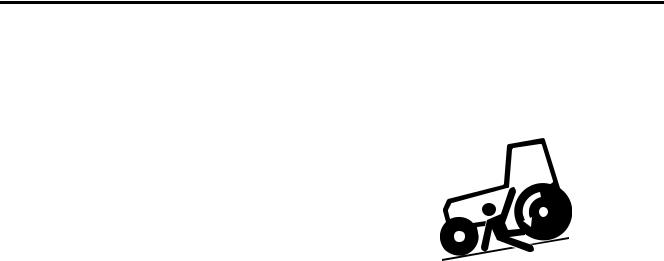
1. SAFETY PRECAUTIONS
8.Avoid accidental contact with control pedals while the engine is running, as this can cause unexpected movement of the tractor.
9.Never leave a running machine unattended.
2. Working with Your Tractor
1.Tow an implement only with the drawbar. Do not hitch via the axle housing. The tractor can upset, leading to serious injury or death. Make certain the drawbar pin is locked in place.
2.Any towed vehicle with a total weight exceeding that of the tractor should be equipped with its own braking system that is operational from the tractor seat.
3.Make sure that all the covers and guards are in position. Replace any missing or damaged cover immediately.
4.Before turning or when traveling on a rough terrain, or before stopping, decrease the tractor speed in order to prevent upsetting.
5.Use extra caution when operating over rough ground, when crossing ditches or slopes, and when turning corners.
6.Do not attempt to turn with the differential lock engaged. Attempting to turn the tractor while the differential lock is engaged can lead to a roll-over.
7.Stay clear of ditches, holes, embankments or ponds. A hazard of tractor upset can occur more easily if the ground is soft or wet. Before entering an area covered with tall grass, walk the area to detect any obstacles.
8.Always watch where you are going, especially at blind corners, trees, or other objects that can obscure your vision. Remain alert when you are approaching the end of a row, trees or any obstacle.
9.When two or more people are working in one area, always keep in good communication with each other.
10.Do not get on or off a moving tractor.
11.Make certain all tractor lights are illuminated when operating at night.
3. Considerations for Safety of Children
Tragic accidents can occur if the operator is not alert to the presence of children. Children are often attracted to the machine. They do not understand the dangers. Never assume they will remain where you last saw them.
1.Keep children out of the operating area and in the watchful care of an adult other than the operator.
2.Be alert if a child enters the work area, stop your tractor immediately.
3.Never allow a child to ride on the tractor. They may fall off and be seriously injured or interfere with safe machine operation.
4.Never allow children under 16 years old to operate the machine. Children 16 years and over should only operate machine under close parental supervision and proper instruction.
5.Be extremely careful when backing the tractor. Before and during backing, look back and downward. A child may be in your path.
6.Use extra care when approaching blind corners, shrubs, trees or other objects that may obscure your vision of a child or other hazard.
7.Never allow a child to play on the tractor or implement.
8.Keep children away from hot or running engines. They may suffer burns.
9.Park your tractor on a solid, flat and level place. Engage the parking brake securely, remove the starter key switch to prevent unauthorized operation. If parking on a slope is unavoidable, park the tractor across the slope and chock the wheels.
1-5 |
Ex2900 / 3200 Operator's Manual |
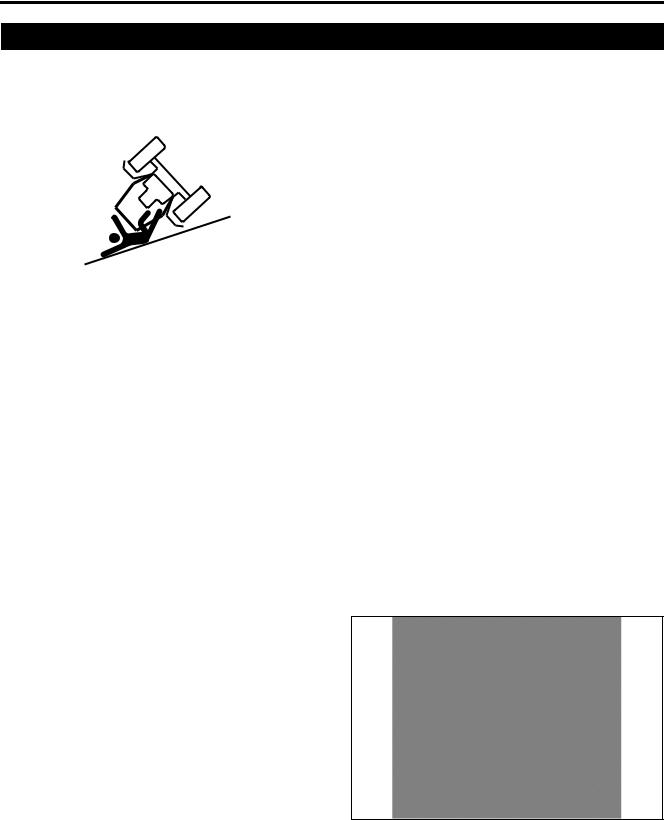
1. SAFETY PRECAUTIONS
5. Operating Your Tractor on Slopes
On a slope, the tractor is less stable and more prone to tip-over, possibly leading to serious injury or death. Remain very cautious when your tractor is on any slope.
A2019005
DO:
●Operate up and down slopes, not across. ●Remove obstacles such as rocks, limbs, etc. ●Watch for holes, ruts or bumps. Uneven terrain
could overturn the machine. Tall grass can hide such obstacles.
●Place the transmission in the low range. When
climbing or descending slopes. Always keep machine in gear when going down slopes to take advantage of engine braking action.
●Keep all movement on the slopes slow and gradual. Do not make sudden changes in speed or direction. Rapid engagement or braking could cause the front of the machine to lift and rapidly flip over backwards which could cause serious injury.
●Avoid starting or stopping on a slope. If tires lose traction, disengage the Power Take Off (PTO) and proceed slowly straight down the slope.
●To avoid upset, move backward up a steep slope. If backing on the slope is not comfortable, do not attempt to continue. Avoid an extremely steep slope.
●When moving forward to escape from a ditch, or deep mud, or when traveling on a steep slope, the risk of the tractor upsetting backward is high. Always move backward to escape these situations. In the four-wheel drive mode, special caution is needed to avoid false confidence in the tractor’s ability to climb slopes.
●To improve stability on a slope, select the widest possible tread. Observe the instructions for appropriate ballasting. (For details, see “TIRES, WHEELS AND BALLAST”)
DO NOT:
●Do not mow near drop-offs, ditches or embankments. The mower could suddenly turn over if a wheel goes over the edge of a cliff or ditch, or if an edge caves in.
 WARNING
WARNING
●Before approaching a slope, select an appropriate speed setting. Be sure to run the tractor at a lower speed on slopes. NEVER attempt a shift change action on a slope. Otherwise, the tractor can suddenly go
downhill out of control.
●On a slope, do not set the range shift lever to the “N” (neutral) position.
●When climbing or descending a slope, do not disengage the clutch or shift the gears. Disengaging the clutch or shifting the gears to neutral position can cause the tractor to be out of control.
●Suddenly starting the tractor on an uphill can cause the front wheels to jump off the ground, and this situation poses an extreme danger. To avoid this problem, run the engine at a lower
speed, and gently start the tractor.
●Do not park the tractor on a slope. If parking on a slope is unavoidable, chock the tires, and engage the parking brake securely.
If the clutch pedal is depressed
3013748
Ex2900 / 3200 Operator's Manual |
1-6 |
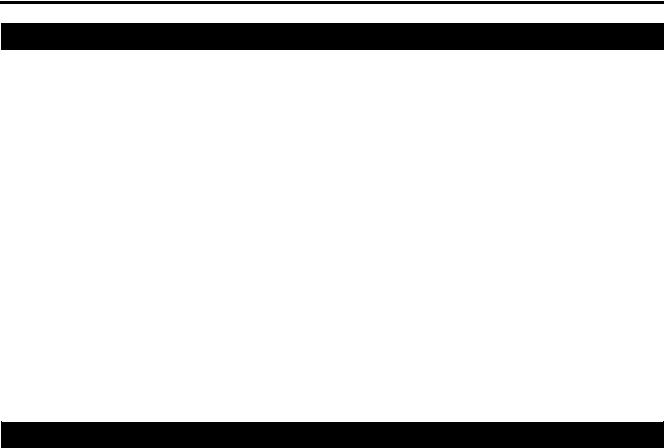
1. SAFETY PRECAUTIONS
6. Traveling on a Road
1.Disengagement of the 4-wheel drive is recommended.
2.Remember that the braking characteristics differ between the two and four wheel drive modes. Be aware of the current drive mode and use carefully.
3.Before turning, always slow down the tractor. High-speed turn may cause the tractor to tip over.
4.When traveling on a road, be sure that the Slow Moving Vehicle (SMV) emblem is on the tractor and is clearly visible. Use the hazard lights and turn lights as required by the currently effective local laws or regulations.
5.Strictly observe all the currently effective local traffic and safety laws and regulations.
6.Turn ON the headlights as required by the currently effective local laws or regulations.
7.Always travel at a speed that allows you to maintain control of the tractor.
8.Avoid engaging differential lock while traveling on a road. It may cause you to lose control of the tractor.
9.While traveling on a road, do not suddenly turn the steering wheel. Such an action can lead to loss in the stability of the tractor, and can cause an extremely dangerous situation.
10.While on a road, do not attempt to operate an implement. During transportation, put the 3-point hitch control lever in its raised position and lock it with the position stop knob. Do not fully close the hydraulic flow control / stop knob to hold an implement in the raised position while the tractor is traveling with the implements.
Doing so could cause damage to the hydraulic lift circuit.
11.When towing another implement, connect a safety chain to the implement and mount a Slow Moving Vehicle (SMV) emblem on it.
7. Safe Practices for Parking Your Tractor
1.Disengage the Power Take Off (PTO), lower the implement to the ground, shift all the levers to their neutral positions, engage the parking brake securely, shut down the engine and remove the starter key switch.
2.Before leaving your tractor, be sure the tractor is completely stopped.
3.Do not park on a steep slope. Rather, park on solid, flat, level ground whenever possible. If parking on a slope is unavoidable, park the tractor across the slope, and lower the implement to the ground and chock the wheels.
4.Allow the tractor to cool at least 5 minutes before storing.
1-7 |
Ex2900 / 3200 Operator's Manual |
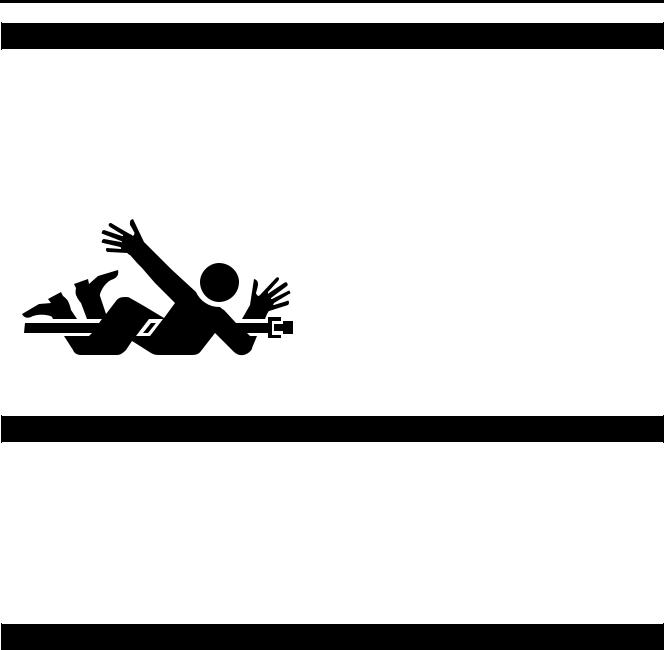
1. SAFETY PRECAUTIONS
8. Operating the Power Take Off (PTO)
1.Before getting off the tractor, connecting/ disconnecting an implement, adjusting, cleaning or servicing a Power Take Off (PTO)-driven implement, make sure that all the moving components are at a standstill.
2.Ensure that the Power Take Off (PTO) shaft cover is always in place. Replace the Power Take Off (PTO) shaft cap only when the shaft is at a standstill.
3.Before installing or operating Power Take Off (PTO)-driven implement, carefully study the manufacturer’s operator’s manual and the safety decals on the implement.
4.When installing stationary Power Take Off (PTO)- drive implements, be sure to engage the parking brake securely and securely place chocks in front and behind the rear wheels. Do not approach or access any rotating component.
9. Using the 3-Point Hitch
1.Use the 3-point hitch only in conjunction with the implement that is specifically designed for use with the 3-point hitch.
2.Before using a 3-point hitch mounted implement, the appropriate counterbalance may need to be installed on the front of the tractor.
3.While on a road, do not attempt to operate an implement. During transportation, put the 3-point hitch control lever in its raised position and lock it with the position stop knob.
Do not fully close the hydraulic flow control / stop knob to hold an implement in the raised position while the tractor is traveling with the implements. Doing so could cause damage to the hydraulic lift circuit.
10. Safety Frame (Roll-Over Protective Structure) (ROPS) Precautions
Your tractor is equipped with a Roll-Over Protective Structure (ROPS) which must be maintained in a fully functional condition. Check overhead clearance carefully before driving under power lines, wires, bridges or low hanging branches, before entering or leaving buildings, or in any other situation where the operator and/or Roll-Over Protective Structure (ROPS) may be stuck, which could result in serious injury.
1.Never modify the Roll-Over Protective Structure (ROPS) in any way.
2.Never attempt to straighten or reweld any part of the main frame or retaining brackets that have been damaged. Doing so may weaken the structure and endanger your safety.
Ex2900 / 3200 Operator's Manual |
1-8 |
3.Never secure any parts on the main frame or attach the safety frame with anything other than the special fasteners specified.
4.Never attach ropes, chains, or cables to the RollOver Protective Structure (ROPS) for pulling purposes.
5.Although the Roll-Over Protective Structure (ROPS) provides you the maximum protection possible, never take unnecessary risks.
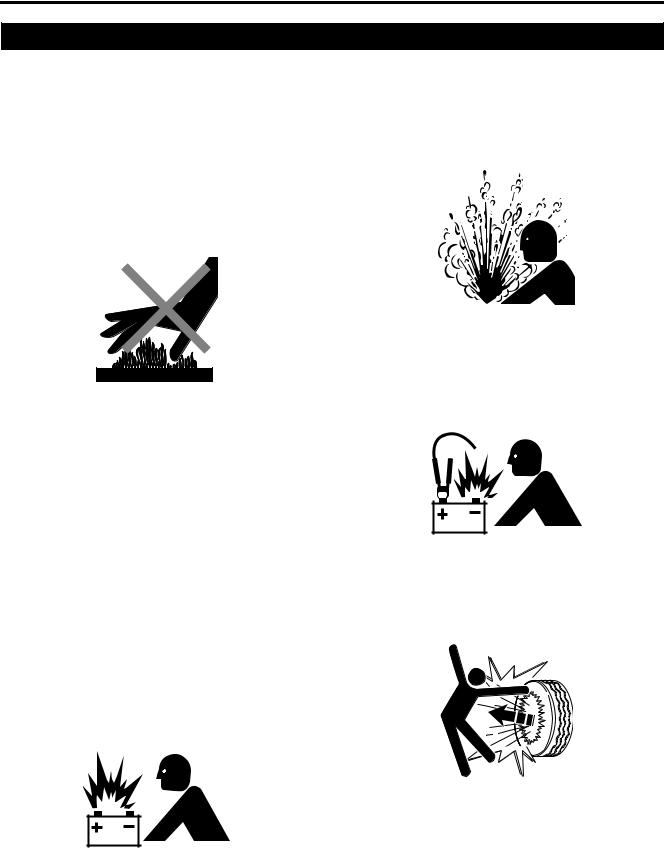
1. SAFETY PRECAUTIONS
11. Safe Practices for Servicing Your Tractor
Before starting any servicing work, park your tractor on solid, level ground, engage the parking brake securely, lower the implement to the ground, set all the levers to the neutral position, shut down the engine and remove the starter key switch.
1.Always keep a first-aid kit and a fire extinguisher readily available.
2.Before accessing the engine, muffler, radiator or other possibly hot components, wait until the tractor has fully cooled off.
10.Carefully loosen the radiator cap to the first stop, and allow excessive pressure to escape, and only then remove the radiator cap. If the tractor is equipped with a coolant reserve tank, add coolant or water to the reserve tank, not to the radiator (See “Checking the Cooling System”).
3.Use extreme care in handling gasoline and diesel fuels. They are extremely flammable and the vapors are explosive. Use only an approved container.
4.Be sure to shut down the engine before refueling. After refueling, replace fuel cap securely and wipe off any spilled fuel before starting the engine as it may cause a fire or explosion.
5.Do not smoke while refueling. Keep any spark or open flame away from the fuel tank.
6.Never refuel the machine indoors because fuel vapors will accumulate in the area.
7.Never store the fuel container or machine inside where there is an open flame or spark, such as a gas hot water heater, space heater or furnace.
8.Do not smoke while working around the battery. Keep any spark or open flame away from the battery. The battery emits hydrogen and oxygen gas, in particular, during recharging and can pose a hazard of explosion.
9.Prior to “jump starting” a tractor that has a fully depleted battery, read and follow all the instructions in the “7. OPERATING THE ENGINE”.
11.Before working on or around electric components, first disconnect the battery ground cable.
12.To prevent a spark occurring from short-circuit, disconnect the battery grounding (–) terminal first and reconnect last.
13.The operator must not mount a tire onto a rim. Only qualified personnel should do this task.
14.Always keep the tires at a correct pressure level. Do not exceed the recommended tire pressure specified in the operator’s manual.
15.Keep the tractor securely supported while changing the wheels or adjusting the wheel tread width. Be sure to tighten the wheel bolts at the specified tightening torque.
1-9 |
Ex2900 / 3200 Operator's Manual |
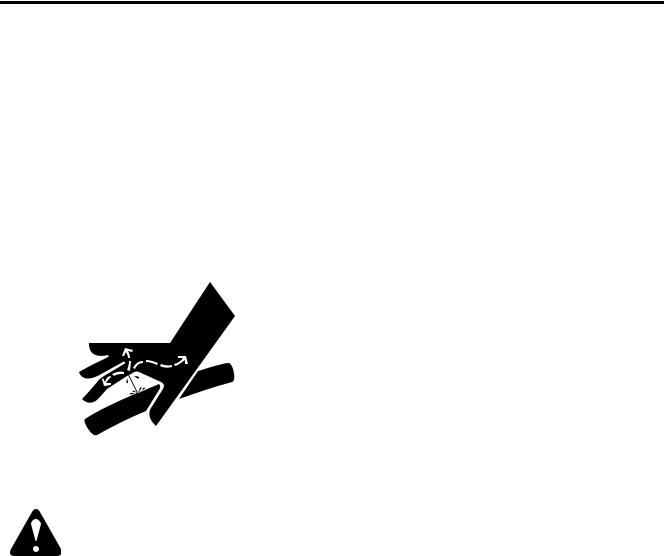
1. SAFETY PRECAUTIONS
16.Avoid working under any hydraulically supported devices. Such devices can settle, suddenly leak down, or be accidentally lowered. If working beneath the tractor, or an implement, is unavoidable, be sure to support the tractor or implement with appropriate stands or lift apparatus.
17.High pressure hydraulic fluid, when released, can penetrate human skin, possibly leading to serious personal injury. Before disconnecting any hydraulic line, fully release the internal pressure. Before exerting a pressure to the hydraulic system, make sure that all connections are tight and all the lines, pipes and hoses are free from fissure/crack or any other damage.
18.Check brake operation frequently. Adjust and service as required.
19.Do not change the engine governor settings or overspeed the engine. Excessive engine speeds are dangerous.
20.Observe proper disposal laws and regulations. Prior to disposal, determine the proper method to dispose of waste from your local Environmental Protection Agency. Recycling centers are established to properly dispose of materials in an environmentally safe fashion.
21.Use proper containers when draining fluids. Do not use food or beverage containers that may mislead someone into drinking from them. Properly dispose of the containers immediately following the draining of fluids.
22.DO NOT pour oil or other fluids into the ground, down a drain or into a stream, pond, lake or other body of water. Observe Environmental Protection Agency regulations when disposing of oil, fuel, coolant, brake fluid, filters, batteries, tires and other harmful waste.
23.We do not recommend the use of a pressure washer or garden hose to clean your unit. They may cause damage to electrical components; spindles; pulleys; bearings; or the engine. The use of water will result in shortened life and reduce serviceability.
WARNING: YOUR RESPONSIBILITY: Restrict the use of this power machine to persons who read, understand and follow the warnings and instructions in this manual and on the machine.
Ex2900 / 3200 Operator's Manual |
1-10 |

1. SAFETY PRECAUTIONS
12.Understanding the Tractor Safety Decals
■Safety-Alert Symbol
The tractor safety decals illustrated in this section are provided in critical areas on the tractor so that people including the operator can remain always aware of potential hazards.
The tractor safety decals contain the words DANGER, WARNING and CAUTION together with the safety-alert symbol. DANGER and WARNING stand for the most serious hazards.
The Operator’s Manual also contains special safety messages that explain potential hazards about which the operator must remain cautious. These messages are presented together with the word CAUTION and the safety-alert symbol.
■Care of DANGER, WARNING and CAUTION Decals
1.Always keep all the danger, warning and caution decals clean and clearly legible.
2.Clean the danger, warning and caution decals with soap water, and wipe dry with clean soft cloth.
3.Replace damaged or missing danger, warning and caution decals with new decals available from your local Cub Cadet Yanmar dealer.
4.If a component having a danger, warning or caution decals is replaced with a new one, make sure that a new decal is on the same location as on the old component.
5.Affix a new danger, warning or caution decals flat on a clean, dry surface, squeezing out trapped air.
1-11 |
Ex2900 / 3200 Operator's Manual |
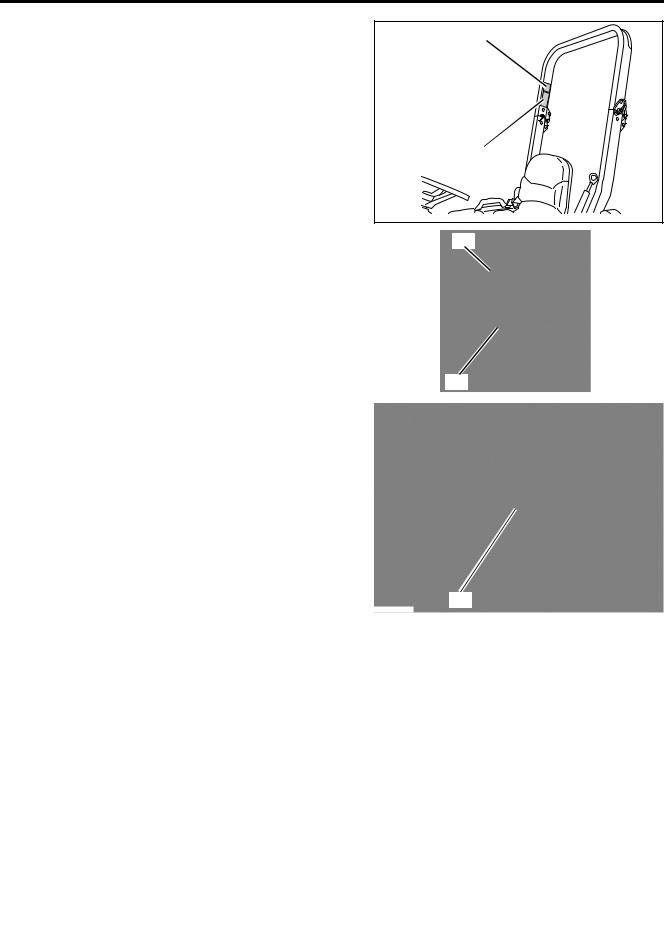
1. SAFETY PRECAUTIONS
(A) CY1A8160-85170
WARNING
This structure's protective capability may be impaired by structural damage, overturn, or alteration.
If any of these conditions occur, the structure must be replaced.
(B) CY1A8160-85180
WARNING
Use retractable seat belt.
(C) CY1A8160-65321
WARNING
1.Read Operator's Manual before operating this tractor.
2.Do not operate the machine without guards, shields, and safety devices in place and working.
3.Hitch towed loads only to drawbar to avoid rearward upset.
4.Make certain everyone is clear of machine before starting engine or operation.
5.Keep all riders off tractor and equipment.
6.Keep hands, feet and clothing away from power - driven parts.
7.Use seat belt. Extend belt completely from any wind - up device before adjusting to fit.
8.Reduce speed when turning or operating around hazards, on rough ground or steep slopes.
9.Do not allow operation of the machine by untrained personnel.
10.Use flashing warning lights on highway unless prohibited by law.
11.Stop engine, lower implement to ground and lock park brake before dismounting.
12.Wait for all movement to stop before servicing machinery.
13.Remove key if leaving tractor unattended.
14.Securely support tractor and implements before working underneath.
(A)
(B)
A3013730
(A)
(B)
P3013720
(C)
P3013727
Ex2900 / 3200 Operator's Manual |
1-12 |
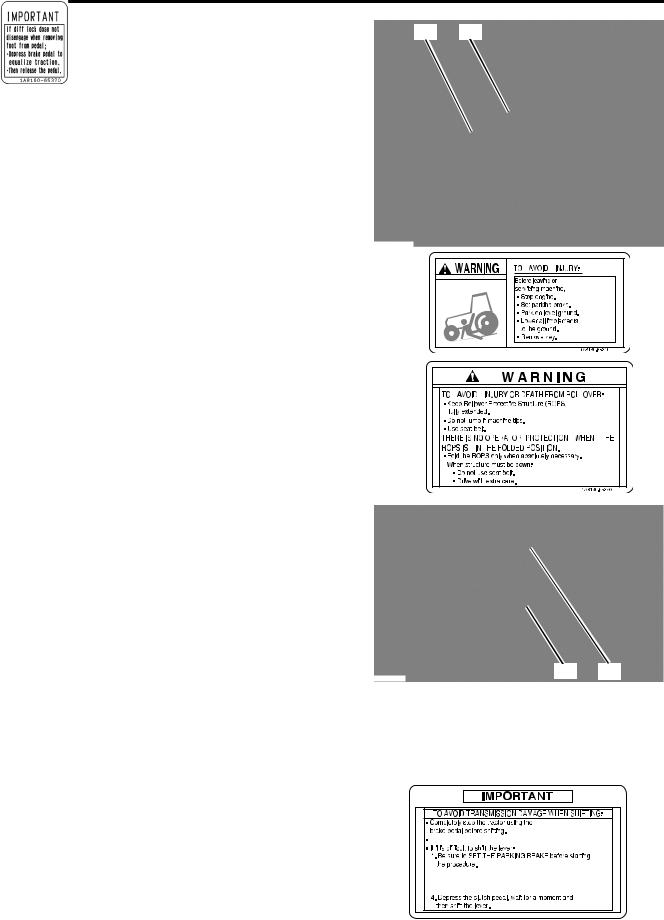
1. SAFETY PRECAUTIONS
(D) CY1A8160-65310
WARNING
TO AVOID INJURY:
Before leaving or servicing machine,
●Stop engine. ●Set parking brake.
●Park on level ground.
●Lower all implements to the ground. ●Remove key.
(E) CY1A8160-65350
WARNING
TO AVOID INJURY OR DEATH FROM ROLLOVER:
●Keep Rollover Protective Structure (ROPS) fully extended.
●Do not jump if machine tips. ●Use retractable seat belt.
THERE IS NO OPERATOR PROTECTION WHEN THE ROPS IS IN THE FOLDED POSITION.
●Fold the ROPS only when absolutely necessary. When structure must be down:
●Do not use retractable seat belt.
●Drive with extra care.
(F)CY1A8160-65370
IMPORTANT
If diff lock does not disengage when removing foot from pedal;
●Depress brake pedal to equalize traction. ●Then release the pedal.
(G) CY1A8160-65360
IMPORTANT
TO AVOID TRANSMISSION DAMAGE WHEN SHIFTING:
●Completely stop the tractor using the brake pedal before shifting.
●Do not force the range gear shift lever.
●If it is difficult to shift the lever;
1.Be sure to SET THE PARKING BRAKE before starting the procedure.
2.Slightly depress the forward / reverse drive pedal to rotate the gears inside of transmission.
3.Release the forward / reverse drive pedal to NEUTRAL position.
4.Depress the clutch pedal, wait for a moment and then shift the lever.
1-13
(D)(E)
P3013728
(F) (G)
P3013729
Do not force the range shift lever.
2.Slightly depress the forward / reverse drive pedal to rotate the gears inside of transmission.
3.Release the forward / reverse drive pedal to neutral position.
1A8160-65360
Ex2900 / 3200 Operator's Manual
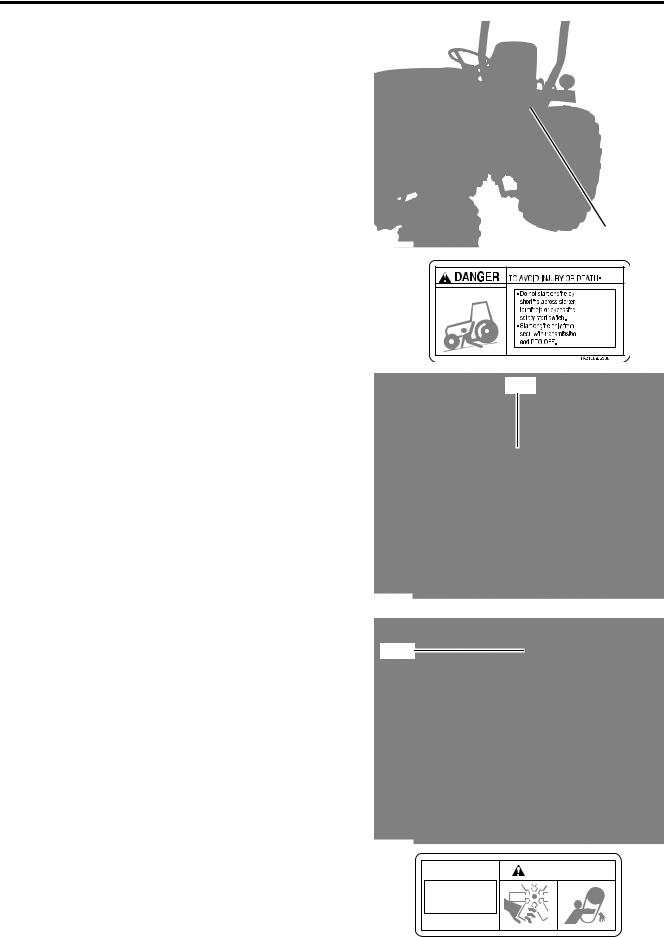
1. SAFETY PRECAUTIONS
(H) CY1A8160-65300
DANGER
TO AVOID INJURY OR DEATH:
●Do not start engine by shorting across starter terminals or bypassing safety start switch.
●Start engine only from seat with transmission and PTO OFF.
(I-a) CY1A8160-51520
DANGER/POISON (E)
●SHIELD EYES: EXPLOSIVE GASES CAN CAUSE BLINDNESS OR INJURY.
●NO SPARKS, FLAMES, SMOKING. ●SULFURIC ACID CAN CAUSE BLINDNESS OR
SEVERE BURNS.
●FLUSH EYES IMMEDIATELY WITH WATER. SEEK MEDICAL HELP RIGHT AWAY.
●KEEP OUT OF REACH OF CHILDREN. DO NOT TIP. ●KEEP VENT CAPS TIGHT AND LEVEL.
(I-b)CY1A7880-65620
WARNING
STAY CLEAR OF ENGINE FAN AND FAN BELT
(H)
P3013739
( I-a )
P3013722
( I-b )
P3013725
WARNING |
STAY CLEAR OF |
ENGINE FAN |
AND FAN BELT |
1A7880-65620 |
Ex2900 / 3200 Operator's Manual |
1-14 |
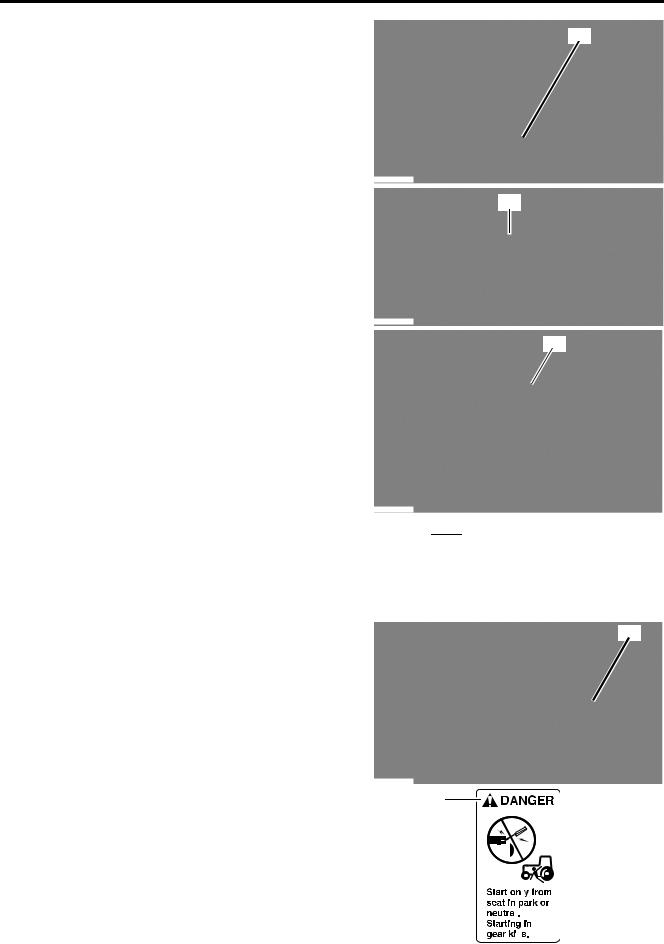
1. SAFETY PRECAUTIONS
(J) CY198220-65621
WARNING
AVOID INJURY FROM PTO:
●Keep all shields in place.
●Keep hands, feet and clothing away. ●Operate only with 540 RPM.
(J)
P3013723
(K) CY124764-44810
CAUTION
1.Adding of water is done through the sub-tank.
2.Before starting, make sure that water level is up to the "Full" mark.
3.If water level is low, remove the cap of the sub-tank and add water until the "Full" mark is reached.
(J)
P3013722
(K)
Q3013702
(L) CY119629-77091
DANGER
Start only from seat in park or neutral. Starting in gear kills.
(K)
(L)
Q3013703
(L)
1-15 |
|
|
|
|
|
|
|
|
|
|
|
|
|
|
|
|
|
|
|
|
|
|
|
|
|
|
|
|
|
|
|
|
|
|
|
|
|
|
|
|
|
|
|
|
|
|
|
|
|
|
|
|
|
|
|
|
|
|
|
|
|
|
|
|
|
|
|
|
|
|
|
|
|
|
|
|
|
|
|
Ex2900 / 3200 Operator's Manual |
|||||||
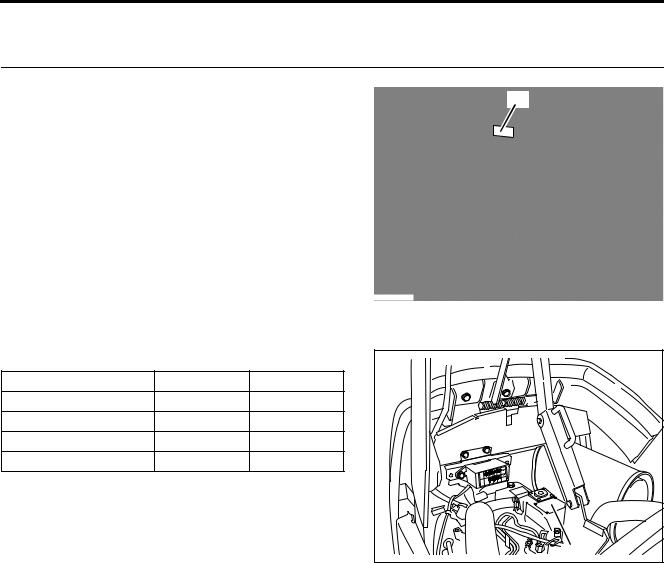
2.SERVICING THE TRACTOR
2.SERVICING THE TRACTOR
Your Cub Cadet Yanmar dealer wants to remain committed to the tractors our customers have purchased and intends to support our customers in fully developing the performance of their Cub Cadet Yanmar tractors. After carefully studying this manual, the customers themselves will be able to do a certain portion of the regular maintenance work.
When parts / components or major service work is needed, contact your local Cub Cadet Yanmar dealer for technical assistance.
For information about the service work, contact your local Cub Cadet Yanmar dealer. When ordering a part / component, inform your local Cub Cadet Yanmar dealer of the tractor and engine serial numbers. Find both serial numbers and enter them in the following table.
Type |
Serial No. |
Tractor
Engine
Date of Purchase
Name of Dealer
(A)Tractor identification plate with tractor serial number
(B)Engine serial number
(A)
P3013726 |
(B) |
3013709 |
Ex2900 / 3200 Operator's Manual |
2-1 |

3.SPECIFICATIONS
3.SPECIFICATIONS
1. Specifications Table
|
|
Model |
|
Ex2900 |
|
Ex3200 |
|
Power Take Off (PTO) Power |
hp (kW) |
22.7 (17.0) |
|
25.5 (19) |
|||
|
Maker |
|
|
|
YANMAR |
||
|
Model |
|
|
|
3TNV88 |
||
|
Type |
|
|
Direct Injection, Vertical, Water-Cooled, 4 Cycle Diesel |
|||
|
Number of Cylinders |
|
|
3 |
|||
|
Bore and Stroke |
in. (mm) |
3.5×3.5 (88×90) |
||||
Engine |
Total Displacement |
cu. in. (L) |
|
100.2 (1.642) |
|||
Gross Power |
hp (kW) |
28.7 (21.4) |
|
31.5 (23.5) |
|||
|
|
||||||
|
Net Power |
|
hp (kW) |
27.4 (20.4) |
|
29.6 (22.1) |
|
|
Rated Revolution |
rpm |
|
2600 |
|||
|
Maximum Torque |
ft•lb (N•m) |
69.4 (94.1) |
|
74.5 (101) |
||
|
Battery |
|
|
12V BP24 , CCA: 540 A |
|||
|
Fuel |
|
|
Diesel Fuel No.1-D , No.2-D |
|||
|
Fuel Tank |
|
US gal (L) |
Approximately 6.3 (24) |
|||
Capacities |
Engine Oil |
|
US qt (L) |
Approximately 4.2 (4.0) |
|||
Engine Coolant |
US qt (L) |
Approximately 4.7 (4.5) |
|||||
|
|||||||
|
Transmission Oil |
US gal (L) |
Approximately 5.4 (20.3) |
||||
|
Overall Length |
in. (mm) |
|
109.5 (2780) |
|||
|
(without 3-Point Hitch) |
|
|||||
|
|
|
|
|
|||
|
Overall Width |
in. (mm) |
|
59.1 (1500) |
|||
|
(with R4 Tires) |
|
|||||
|
|
|
|
|
|||
|
Overall Height |
in. (mm) |
|
87.8 (2230) |
|||
|
(with Roll-Over Protective |
|
|||||
|
Structure (ROPS), R4 Tires) |
|
|
|
|
||
Dimensions |
Overall Height |
in. (mm) |
|
54.2 (1390) |
|||
|
(with R4 Tires) |
|
|||||
|
(Top of Steering Wheel) |
|
|
|
|
||
|
Wheel Base |
in. (mm) |
|
61.0 (1550) |
|||
|
Min. Ground Clearance |
in. (mm) |
|
10.0 (255) |
|||
|
(with R4 Tires) |
|
|||||
|
|
|
|
|
|||
|
Tread |
Front |
in. (mm) |
|
38.3 (974) |
||
|
(with R4) |
Rear |
in. (mm) |
|
43.9 (1114) |
||
Weight (with Roll-Over Protective |
lb (kg) |
2495 (1134) |
|
2500 (1136) |
|||
Structure (ROPS) and R4 Tires) |
|
||||||
|
|
|
|
||||
3-1 |
Ex2900 / 3200 Operator's Manual |

3. SPECIFICATIONS
|
|
Ag (R1) |
Front |
7-14 |
|
|
|
Rear |
11.2-24 |
||
|
|
|
|||
|
Tire |
Turf (R3) |
Front |
25×8.50-14 |
|
|
Rear |
13.6-16 |
|||
|
|
|
|||
Traveling |
|
Industrial (R4) |
Front |
25×8.50-14 |
|
|
Rear |
15-19.5 |
|||
System |
|
|
|||
Clutch |
|
|
Dry Type Single Stage |
||
|
|
|
|||
|
Steering |
|
|
Power Steering |
|
|
Transmission |
|
Hydrostatic Transmission, 3 Range Speeds |
||
|
Brake |
|
|
Wet Multi-Plates |
|
|
Minimum Turning Radius |
ft (m) |
8.7 (2.7) |
||
|
Hydraulic Control System |
|
Position Control |
||
|
Pump Capacity (main) |
US gal/min |
Approximately 5.6 (21.1) |
||
|
(L/min) |
||||
|
|
|
|
||
|
Pump Capacity (steering) |
US gal/min |
Approximately 4.3 (16.4) |
||
Hydraulic |
(L/min) |
||||
|
|
|
|||
Unit |
3-Point Hitch |
|
Category 1 |
||
|
Max. Lift |
Lift Point |
lb. (kg) |
1250 (568) |
|
|
24 in. Behind |
|
|
||
|
Force |
lb. (kg) |
1100 (500) |
||
|
|
Lift Point |
|
|
|
|
System Pressure |
psi (MPa) |
2030 (14) |
||
|
|
Shaft Size |
|
SAE 1-3/8, 6-Splines |
|
|
Rear |
Type |
|
Continuous Live with Overrunning Clutch |
|
Power Take |
|
Speed / Engine |
rpm |
540 / 2592 |
|
Off (PTO) |
|
Shaft Size |
|
SAE 16/32, 15-Splines |
|
|
Mid |
Type |
|
Continuous Live |
|
|
|
Speed / Engine |
rpm |
2100 / 2630 |
|
2. Traveling Speeds
(At rated engine rpm)
|
Model |
|
|
Ex2900 / 3200 |
|
|
|
Rear Tire Size |
11.2-24 (Ag) |
13.6-16 (Turf) |
15-19.5 (Industrial) |
||||
|
Range Shift Lever |
mph |
km/h |
mph |
km/h |
mph |
km/h |
|
1 |
4.0 |
6.5 |
3.4 |
5.6 |
3.5 |
5.7 |
Forward |
2 |
6.9 |
11.1 |
5.9 |
9.5 |
6.1 |
9.8 |
|
3 |
13.2 |
21.3 |
11.3 |
18.3 |
11.7 |
18.8 |
|
1 |
4.0 |
6.5 |
3.4 |
5.6 |
3.5 |
5.7 |
Reverse |
2 |
6.9 |
11.1 |
5.9 |
9.5 |
6.1 |
9.8 |
|
3 |
13.2 |
21.3 |
11.3 |
18.3 |
11.7 |
18.8 |
Ex2900 / 3200 Operator's Manual |
3-2 |

4.IMPLEMENT CAPACITIES
4.IMPLEMENT CAPACITIES
The Cub Cadet Yanmar tractor has been carefully tested in the configuration equipped with implements sold or approved by Cub Cadet Yanmar and has proved to perform properly. Do not use any implement that has not been sold or recommended by a Cub Cadet Yanmar dealer, or that fails to satisfy the specified values given below. Never mount an implement that is not approved for the Cub Cadet Yanmar tractor. Using unapproved implements could result in malfunction, failure, and damage to the tractor and/or implement, and increase the possibility of injury to the operator or other people. The Cub Cadet Yanmar warranty does not cover any malfunction or failure that results from use of an unapproved implement.
|
Lower Link End |
Implement Weight |
|
Trailer Loading Weight |
|
Maximum Lifting |
Maximum Drawbar Load |
||
|
and Size |
Maximum Capacity |
||
|
Capacity |
|
||
|
|
|
|
|
|
W0 |
W1 |
W2 |
W3 |
lb |
1250 |
As specified in the list |
726 |
2200 |
kg |
568 |
shown in the next page |
330 |
1000 |
W0
W2 W3
W1
A3013714
4-1 |
Ex2900 / 3200 Operator's Manual |

4. IMPLEMENT CAPACITIES
Implement |
Remarks |
Unit |
Amount |
|||
Trailer |
Maximum Load Capacity |
lb (kg) |
2200 |
(1000) |
||
Maximum Drawbar Load |
lb (kg) |
726 |
(330) |
|||
|
|
|||||
|
Rotary-Cutter |
Maximum Cutting Width |
in. (mm) |
60 (1525) |
||
|
(Brush Hog) |
Maximum Weight |
lb (kg) |
570 |
(260) |
|
Mower |
Flail Mower |
Maximum Cutting Width |
in. (mm) |
50 (1270) |
||
Maximum Weight |
lb (kg) |
650 |
(295) |
|||
|
|
|||||
|
Sickle Bar |
Maximum Cutting Width |
in. (mm) |
72 (1829) |
||
|
Maximum Weight |
lb (kg) |
620 |
(280) |
||
|
|
|||||
Rotary Tiller |
Maximum Tilling Width |
in. (mm) |
60 (1525) |
|||
Maximum Weight |
lb (kg) |
550 |
(250) |
|||
|
|
|||||
Box Scraper Box Blade |
Maximum Cutting Width |
in. (mm) |
60 (1525) |
|||
Maximum Weight |
lb (kg) |
530 |
(240) |
|||
|
|
|||||
Rear Blade |
Maximum Cutting Width |
in. (mm) |
72 (1829) |
|||
Maximum Weight |
lb (kg) |
300 |
(135) |
|||
|
|
|||||
Landscape Rakes |
Maximum Cutting Width |
in. (mm) |
72 (1829) |
|||
Maximum Weight |
lb (kg) |
300 |
(135) |
|||
|
|
|||||
Post Hole Digger |
Maximum Digging Depth |
in. (mm) |
48 (1220) |
|||
Maximum Weight |
lb (kg) |
200 (90) |
||||
|
|
|||||
Broadcaster |
Maximum Tank Capacity |
US gal (L) |
Approximately 53 (200) |
|||
Maximum Weight |
lb (kg) |
220 |
(100) |
|||
|
|
|||||
Disk Harrow: Pull-Type |
Maximum Harrowing Width |
in. (mm) |
60 (1525) |
|||
Maximum Weight |
lb (kg) |
550 (1210) |
||||
|
|
|||||
Manure Spreader |
Maximum Capacity |
lb (kg) |
2200 |
(1000) |
||
Cultivator |
Maximum Width |
in. (mm) |
60 (1525) |
|||
Maximum Weight |
lb (kg) |
350 |
(160) |
|||
|
|
|||||
Bottom Plow |
Maximum Width |
in. (mm) |
12in.×2 |
|||
Maximum Weight |
lb (kg) |
500 |
(230) |
|||
|
|
|||||
|
|
Maximum Lift Capacity (at Pivot) |
lb (kg) |
900 |
(410) |
|
Front-End Loader |
Maximum Overhang (Pivot ~ Front Tire Center) |
in. (mm) |
32 (810) |
|||
Maximum Weight |
lb (kg) |
870 |
(395) |
|||
|
|
|||||
|
|
Maximum Oil Pressure |
psi (MPa) |
2175 (15) |
||
|
|
Maximum Digging Depth |
in. (mm) |
90 (2285) |
||
Backhoe |
Maximum Weight |
lb (kg) |
980 |
(445) |
||
|
|
Maximum Oil Pressure |
psi (MPa) |
2175 (15) |
||
Mid-Mower |
Maximum Cutting Width |
in. (mm) |
60 (1525) |
|||
Maximum Weight |
lb (kg) |
450(205) |
||||
|
|
|||||
Ex2900 / 3200 Operator's Manual |
4-2 |
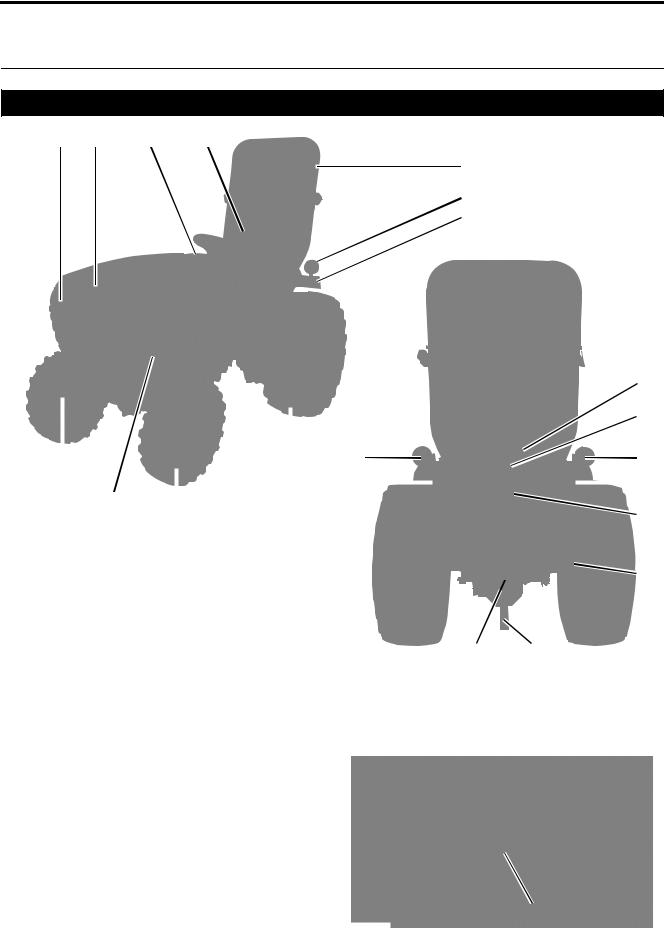
5.NAMES AND FUNCTIONS OF COMPONENTS
5.NAMES AND FUNCTIONS OF COMPONENTS
1. Appearance
(1) |
|
(2) |
|
(3) |
|
(4) |
(5)
(6)
(7)
|
|
|
|
|
|
|
|
|
|
|
|
|
(12) |
|
|
|
|
|
|
|
|
|
|
|
|
|
|
(13) |
|
|
|
|
|
|
|
|
|
|
|
|
|
|
||
|
|
|
|
|
|
|
|
|
|
|
|
|
||
|
|
|
|
|
|
|
|
|
|
|
|
|
|
|
|
|
|
|
|
|
(6) |
|
(6) |
||||||
|
|
|
|
|
|
|
|
|
|
|
|
|
(14) |
|
|
|
|
|
|
|
|
|
|
|
|
|
|
||
|
|
|
|
|
|
(14) |
|
|
|
|||||
|
|
|
|
|
|
|
|
|||||||
P3013739 |
(11) |
(10) |
|
|
|
|
|
|
|
|
|
|
|
|
|
|
|
(9) |
(8) |
|
|
|
|
|
|
(15) |
|||
|
|
|
|
|
|
|
|
|
|
|
|
|
|
|
|
|
|
|
|
|
|
|
|
|
|
|
|
(16) |
|
|
|
|
(18) |
|
(17) |
|
|
|
(1) |
Headlights |
(16) Lower links |
|
|
|
|
|
|
|
|
|
|
|
||||
(2) |
Hood |
(17) Drawbar |
|
|
|
|
|
|
(3) |
Fuel inlet |
(18) Rear Power Take Off (PTO) shaft |
||||||
(4) |
Seat |
(19) Hydraulic quick couplers |
||||||
(5) |
Roll-Over Protective Structure (ROPS) |
|
|
|
|
|
|
|
(6) |
Turn signal / Hazard lights |
|
|
|
|
|
|
|
(7) |
Fender |
|
|
|
|
|
|
|
(8) |
Rear tires |
|
|
|
|
|
|
|
(9) |
Front tires |
|
|
|
|
|
|
|
(10) Side panel |
|
|
|
|
|
|
|
|
(11) Front weight hitch |
|
|
|
|
|
|
|
|
(12) Slow Moving Vehicle (SMV) emblem |
|
|
|
|
|
|
|
|
(13) Top link |
|
|
|
|
|
|
|
|
(14) |
Tail lights |
P3013709 |
|
(19) |
|
|||
(15) Top link retainer |
|
|
|
|
|
|||
|
|
|
|
|
|
|
||
|
5-1 |
Ex2900 / 3200 Operator's Manual |
||||||
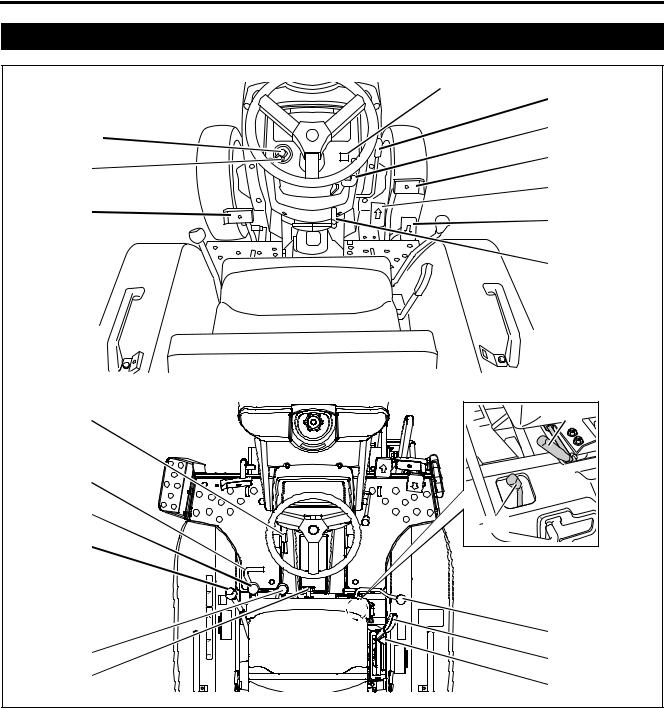
5.NAMES AND FUNCTIONS OF COMPONENTS
2.Operator Station Controls
|
(3) |
(4) |
|
|
|
(1)(2) |
|
(5) |
|
|
|
(11) |
|
(6) |
|
|
|
|
|
(7) |
(10) |
|
(8) |
|
|
|
|
|
(9) |
A3013703 |
|
|
(12) |
|
(13) |
|
|
|
(22) |
|
|
(21) |
|
(14) |
|
|
|
(20) |
|
3013712b |
|
|
|
|
|
(15) |
(19) |
|
(16) |
(18) |
|
|
|
(17) |
|
3013703 |
|
(1) |
Multi-function switch |
(13) Seat adjustment lever |
(2) |
Headlight switch |
(14) Hydraulic lock lever |
(3) |
Hazard lights button switch |
(15) Implement control lever |
(4) |
Throttle control lever |
(16) 3-point hitch control lever |
(5) |
Cruise control lever |
(17) Position stop knob |
(6) |
Brake pedal |
(18) Hydraulic flow control / stop knob |
(7) |
Forward drive pedal |
(19) Rear Power Take Off (PTO) engagement lever |
(8) |
Reverse drive pedal |
(20) Range shift lever |
(9) |
Parking brake lever |
(21) Mid-Power Take Off (PTO) engagement lever |
(10) Clutch pedal |
(option) |
|
(11) Turn signal switch |
(22) Differential lock foot pedal |
|
(12) |
4-wheel drive lever |
|
Ex2900 / 3200 Operator's Manual |
5-2 |
|
